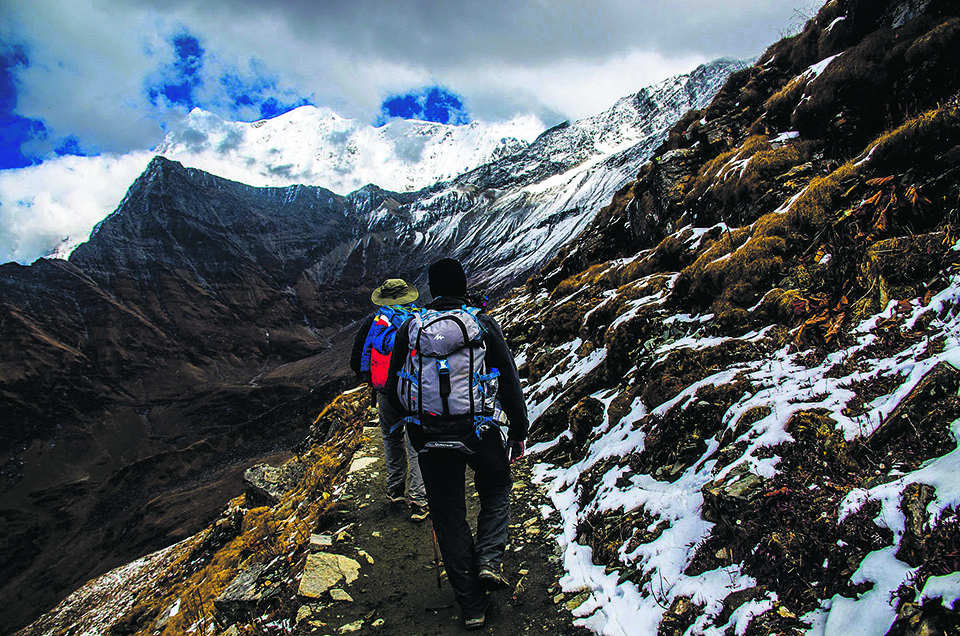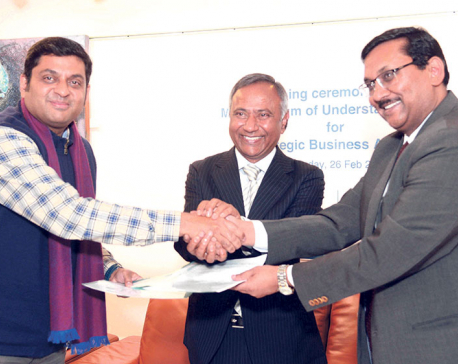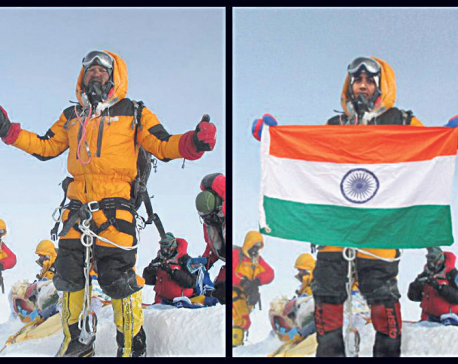
OR
Cover Story

When 22-year-old Pratik Paudel was on his way to the Everest Base Camp, he was stricken with fear. Pratik, a photographer by profession, had only recently started traveling and lack of experience made him extremely anxious. And to make matters worse, he suffered from altitude sickness. Sick and frightened, he was all set to make the return trip home.
Just then, as he lay in a cot, a young woman approached him and urged him to carry on. She was an experienced climber and was there to climb the Lobuche peak, and that too solo. Barely a few years older than him, she inspired Pratik to complete his trek to EBC. Pratik never got to know the woman’s name but he remembers her every time he is stuck and doubting himself. It’s because of her that he hopes to join the ranks of expert mountain-climbers some day.
With Nepali climbers making records like never before, it’s an exciting time especially for those who are just starting out or dream of giving it a shot someday. Lhakpa Tenzing Sherpa (better known as Apa Sherpa) held the record for climbing Mt Everest more times than anybody else had until 2017. Then Kami Rita Sherpa, another Nepali, broke the record by climbing the peak 24 times. And just recently Dawa Yangzum Sherpa made headlines for becoming the first female Nepali woman to climb Mt Makalu (the fifth highest peak) and the first Nepali athlete to join the North Face team.
Pemba Gyaltsen Sherpa (mostly known as Pega Sherpa), 24, began his journey in the mountains right after high school. Although he was born in Solukhumbu, his was a family of non-climbers and he grew up in Kathmandu. “Despite my name, there really wasn’t anything that would have led me to mountain climbing,” he says. Growing up with images of mountains however put them on the back of his mind and he constantly wondered how it would feel to be up on the peaks. Once he finished high school, he went back to his village in Phortse that is located right above Namche Bazaar. He had decided that he would make a career in mountain climbing.
His parents weren’t very enthusiastic about the idea because he was essentially a “town kid” who barely had any outdoor experiences. But he persisted, took climbing courses and is now a certified guide who leads expeditions to the top of mountains. Since starting out, he has successfully climbed Mt Everest a total of three times (out of six attempts), climbed Cho Oyu (8,201m), Hiunchuli (6,441 m) and made numerous ascents to Island Peak (6,189m), Lobuche Peak (6,119m) and Mera Peak (6,476m).
“I had every intention of making a career out of climbing mountains. But I started at 18 and I obviously didn’t have any experience. My parents didn’t think I could do it nor was I particularly certain myself. But I did one thing and then another and eventually things worked out for me,” says Pega. But he admits that climbing is neither an easy task nor is it something you can prepare for in just a few weeks. Even with intensive climbing courses, climbing mountains of lower altitudes can take years. It took Pega four years of rigorous practice before he could even attempt to climb Mt Everest. The first couple of times he had to return owing to bad weather or altitude sickness.
Mt Everest is a dream for many as it is for 21-year-old Tshering Yanjee Sherpa. A tourism student, Tshering has yet to attempt climbing a peak but she has completed a basic climbing course and is moving up to the intermediate level. Every day she hears of young Nepali climbers making it to the top of various peaks and at record times and she trains harder because she too wants to be counted among them. “But there is no point in being impatient. From core training to nailing the techniques, it will take me a while,” she says.
Tshering has been working as a trekking guide for three years now and is either rock climbing or wall climbing whenever she has the time. “It’s all preparation,” she adds. Tshering’s instructor, Tul Singh Gurung, stresses on the importance of being technically sound before even attempting to climb a mountain. As someone who started at the age of 20 and has nearly two decades of experience in climbing, he is an instructor to many young climbers.
He suggests young climbers to train in climbing, try scaling a few 6,000 meter peaks to get acclimatized to the altitude, make their way up to 7,000 meters and then finally attempt the 8,000 meter peaks. “The climb is thrilling but there are a lot of risks involved and training and taking time is the best way to prepare yourself,” he explains.
20-year-old Ashok Lama has climbed one of the most difficult peaks on the planet. Ama Dablam stands at 6,812 meters from sea level and is inarguably one of the best looking peaks in the Himalayan belt. Ashok found himself using everything he had learnt during training when climbing Ama Dablam. “There are a lot of rocks there so it’s a very technical climb,” he says. This climbing season Ashok will take on Mt Manaslu and he doesn’t expect the climb to be any easier this time around.
There are also times when climbers do things their own way. Mingmar Yangzi Sherpa is 24 years old and very much like the young woman Pratik encountered. She too climbs solo. When she first climbed Island Peak she looked for a friend to accompany her but everyone she approached turned her down. Tired of waiting, she decided to go on her own.
“There were always people climbing so I wasn’t really alone but none of them knew me so it did feel like a solo ascent,” she says. Although Mingmar frequently does rock climbing, cycling and other physically challenging activities, she had no formal training in mountain climbing. “It’s not the smartest thing to do and I found myself at a disadvantage many times. After Island Peak I took a course on ice training and that has helped me quite a lot,” she adds.
Always an adventurous kid, Mingmar wanted to make a career in tourism but her parents didn’t
approve of this and urged her to study nursing. Mingmar then went on to get a nursing degree but she soon found out that working under a strict system with set hours just wasn’t for her. She quit her job and took up a position at an NGO that is much more flexible with the working hours and work conditions.
Since taking up her new position, Mingmar has made the trip to Everest Base Camp all on her own and climbed both Lobuche Peak and Island Peak without assistance. “When people hear that I’m on my own they motivate me. At times when it gets hard, their encouragement really helps,” she says. This October, Mingmar, like Ashok, is attempting Mt Manaslu (8,156m) which is a great leap for her considering the fact that she has only climbed 6,000 meter peaks. This time, however, she will have a guide with her.
Each climber this scribe spoke to agreed that mountain climbing is thrilling but extremely difficult too. And that it would be a great mistake to attempt to climb one without proper training. However, it would be a sin to never try to go up a mountain was also the unanimous belief. Up on the peak, they say, it feels like a different world altogether. The only thing that is on the mountain-climbers minds when they make their inevitable descent is to go back again.
rakshya.khd@gmail.com

You May Like This

Nepal online trade: Decorating Nepal
Nepal Online Trade is a business initiative of Sajak Yonjan that sells décor materials imported from China, Hong Kong, and... Read More...

Standard Chartered Bank Nepal, Nepal Mediciti join hands
KATHMANDU, Mar 1: Standard Chartered Bank Nepal Ltd (SCBNL) and Nepal Mediciti have signed an agreement to provide various discounted... Read More...

Nepal bans Indian police couple for faking Everest climb
KATHMANDU, Aug 30: Nepal has imposed a 10-year mountaineering ban on an Indian couple who faked photographs purporting to show... Read More...







Just In
- NRB to provide collateral-free loans to foreign employment seekers
- NEB to publish Grade 12 results next week
- Body handover begins; Relatives remain dissatisfied with insurance, compensation amount
- NC defers its plan to join Koshi govt
- NRB to review microfinance loan interest rate
- 134 dead in floods and landslides since onset of monsoon this year
- Mahakali Irrigation Project sees only 22 percent physical progress in 18 years
- Singapore now holds world's most powerful passport; Nepal stays at 98th











Leave A Comment